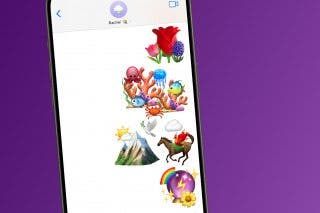Should You Buy the New iPhone X? Plus, the New Apple Watch, Apple TV & More


Should you upgrade to Apple's $1,000 new iPhone X or defend your dollars and opt for one of the more reasonably priced iPhone 8 models? Sarah and David fiercely debate this point in the 66th episode of the iPhone Life Podcast following Apple's tenth-anniversary event. The team also analyzes the significance of the tech giant's other big updates, from the cellular-enabled Apple Watch Series 3 to the 4K Apple TV.
Click here to listen and subscribe. If you like what you hear, be sure to leave a review. And remember to tune in every other week to hear our editors share with you the latest Apple news, best apps, iPhone tricks, and coolest accessories.
This episode is brought to you by Gobudi and Otterbox. Meet the modular uniVERSE case ($49.95). The uniVERSE case has a detachable plate on the back that slides on and off. When off, you can slide any of the modular additions onto the case for endless possibilities. Use the wallet module to keep your credit cards nearby, use the battery pack module to extend the life of your iPhone, or use the card reader to go from casual to business in seconds. No more constantly adjusting your AirPods throughout a workout; with EARBUDi ($9.99) from Gobudi, your AirPods will never fall out, guaranteeing frustration-free exercise. EARBUDi keeps your AirPods secure so you can focus on whatever you’re doing, whether that be sports, weightlifting, or rock climbing.
This podcast was recorded using high-quality microphones from Blue Microphone.
Question of the week:
Which iPhone will you buy, an iPhone 8, 8 Plus, or iPhone X? Or will you stick with an older model iPhone? Email podcasts@iphonelife.com to let us know.
Articles and links referred to in this episode:
- Everything You Need to Know about the New Apple Watch Series 3 & watchOS 4
- New Apple TV 4K Announced
- Everything You Need to Know About New iPhone X, iPhone 8, 4K Apple TV, & Apple Watch Release
- Op-Ed: The iPhone Announcement Lived Up to the Pre-event Hype
- Meet Apple’s New Lineup: My Favorite Features of iPhone X & iPhone 8 Models
Useful links:
- Become an iPhone Life Insider
- Sign up for the free Tip of the Day Newsletter
- Email the Podcast
- Subscribe to iPhone Life magazine
Transcript of Episode 66:

Donna Cleveland: Hi, and welcome to episode 66 of the iPhone Life podcast. We're here with special coverage of the Apple event that just took place earlier today. I'm Donna Cleveland, Editor-in-Chief at iPhone Life.
David Averbach: I'm David Averbach, CEO and Publisher at iPhone Life.
Sarah Kingsbury: I'm Sarah Kingsbury, Senior Web Editor at iPhone Life.
David Averbach: We did it, guys, officially Apple announcement day. How you feeling?
Sarah Kingsbury: Whoo!
Donna Cleveland: I know. Definitely, adrenaline's been running high here as we've been live tweeting and writing updates to post on our website. I think it's been going great, though.
Sarah Kingsbury: Yeah. There was a big leak over the weekend of iOS 11 details that pretty much told us everything they were going to announce, but it was still exciting.
Donna Cleveland: Yes.
David Averbach: Yeah, it was blast. It was a really great announcement.
Donna Cleveland: Here at the office, we always get a bunch of pizzas, watch the announcement, and have a blast here so ...
David Averbach: And this year, our CTO made us a really fancy dessert. What was it called? Anybody know?
Sarah Kingsbury: Posset with berries.
David Averbach: Lemon posset. It was really good.
Sarah Kingsbury: Yes.
Donna Cleveland: So-
David Averbach: And moving right along.
Donna Cleveland: Yeah. So this episode, we're going to tell you everything that Apple announced. You probably are already aware of this, that Apple announced a new iPhone X, their premium model, an iPhone 8 and 8 Plus, and also, a new cellular enabled Apple Watch and a 4K Apple TV. So we have a lot to cover here. We'll give you the details of those updates and let you know what we thought of those updates. And also, we're going to have our yearly David versus Sarah debate.
David Averbach: David versus Sarah.
Sarah Kingsbury: Which I will win, as usual.
Donna Cleveland: And this debate this year will center around if you're upgrading to one of the new phones, should you update to the iPhone 8 or 8 Plus, or should you spend that extra money and get the iPhone X? We do this each year because we know that all of you guys face the dilemma of which one to buy because it's not a small investment.
David Averbach: Especially this year, really not a small investment.
Donna Cleveland: I know.
Sarah Kingsbury: $200 is the difference between the base Plus model phone and the base X phone.
Donna Cleveland: Yeah.
David Averbach: Yeah.
Donna Cleveland: And even though it is just, I mean, $200 is a lot, but hitting the $1000 mark definitely feels intense.
David Averbach: Yeah.
Sarah Kingsbury: You can guy a nice laptop for that much.
David Averbach: Yeah.
Donna Cleveland: Yeah, so the iPhone X's a big investment, so we want to help you weight the pros and cons and help you not get just caught up in the new buzz features and really know if these are going to make a difference in your life or not. So we'll be getting into all that and more, but first, we want to share with you our sponsor for this episode. We have two sponsors, and our first one is Otterbox.
David Averbach: Alright, so one of the interesting developments, and we all saw this coming, but the new iPhones have a glass back for the wireless charging. I have been a proponent for years of only putting a glass screen protector on the screen and not using a case. Well, I am going to backpedal real quick from that one with a glass back. Also, side note, I've now broken my screen a couple of times, so I've already been backpedaling slowly over the last six months on this. So everybody, and I mean everybody's going to be in the market for a case. And the OtterBox uniVERSE series is a really great option. If you're watching this, I'm holding it up right now. And what makes it so great is on the back, they have this little clip right here. If you're watching, you can see I can slide it out really easily, and it has, they worked with a whole host of third-party accessories that work with this. So you can slide in a battery pack there to charge it, you can do a wallet case if you're going out for the evening. They worked with camera manufacturers to have a lens, all these different accessories.
Sarah Kingsbury: And I have, actually, I have a tripod.
David Averbach: Okay.
Sarah Kingsbury: Like a camera tripod. It's really, it's ...
Donna Cleveland: Oh, that's awesome.
Sarah Kingsbury: What I love about these accessories, sorry, I'm just taking this over, David ... I'm a big fan of this case series, is that a lot of times when case makers make these cases, they come up with their own versions ...
David Averbach: Yes, exactly.
Sarah Kingsbury: ... but they're not as good, and Otterbox skipped that, and said, no, we're going to work with the manufacturers that have got this down that make the best versions of these accessories and make them compatible with our cases so that you don't have to make do with some second-best version.
David Averbach: Yeah, so for example, for the battery pack, they partnered with Mophie who's the industry leader in the battery packs. Make sure you check this out, it's a really good option that allows you to integrate with a bunch of third-party accessories and a really solid protective case.
Donna Cleveland: Yeah. I feel like if you're looking for an all-around protective case, basically, any Otterbox case will do a good job.
David Averbach: Mm-hmm (affirmative).
Donna Cleveland: They're such an industry leader this way.
David Averbach: Yes.
Sarah Kingsbury: And they have such a good range of really rugged looking protective cases, and, also, really fashionable looking protective cases, so it's not like the days when if you wanted protection, you had to just stick with the giant utility looking case. You can actually get some really attractive fashionable cases.
David Averbach: Side note: This is not the case we're promoting today, but the Strata case, the Otterbox Strata case has premium leather back, and it's really beautiful. So there's a lot of options out there for cases, and Otterbox is really a great option.
Donna Cleveland: Yes. And we also want to do a quick plug for our Tip of the Day newsletter. This episode, we mainly just want to stick to the Apple announcement, but this is the one that's particularly relevant because iOS 11 is coming out September 19th.
Donna Cleveland: Yeah, so with our Tip of Day newsletter, we send one tip to you each day to your email inbox that teaches you something you can do with your phone, and this time of year, this newsletter's particularly invaluable because we'll teach you how to update to iOS 11, how to use the cool new features, you get a little tidbit each day. So if you go to iphonelife.com/dailytips, you can sign up for that, and we wanted to share the tip with you this week of how to update to iOS 11. You're probably wondering how to prep your phone, how to get ready for iOS 11, and we wanted to help you out with that. So if you have an iPhone 5S or later, you are able to update to iOS 11. If you have an iPhone 5S, though, I don't know that I would recommend it.
David Averbach: Yeah.
Sarah Kingsbury: I always let other people try it first and see how it goes for them.
Donna Cleveland: Yes.
David Averbach: Even with the 6, I think the same advice. Wait a week or two, see if internet explodes with people with the 6 complaining about a slow phone and then upgrade. If you have the 7 or if you are lucky enough to get one of the new phones, then definitely upgrade. iOS 11's going to be great.
Donna Cleveland: Yes.
Sarah Kingsbury: Even sometimes it doesn't go well for the older phones, and then Apple will issue some small update ...
David Averbach: Fix, yeah.
Sarah Kingsbury: ... that will fix it, so it's definitely worth waiting.
David Averbach: Mm-hmm (affirmative).
Donna Cleveland: And the new phones will actually ship with iOS 11, so you don't even have to worry about that.
David Averbach: This is true.
Donna Cleveland: So the first thing you want to do is back up your iPhone, so you want to make sure all of your data is safe on your phone. So you just can go into settings and then tap your Apple ID profile up at the top of the screen, go to iCloud and then iCloud backup. And you'll have an option there to back up now, so make sure that's complete. You can also do an iTunes backup by plugging in your phone to your MacBook or whatever laptop you have and backing up through iTunes that way. I usually like to use iCloud just because it's easier.
David Averbach: It's way nicer.
Sarah Kingsbury: Yeah, I do iCloud, too. Some people don't have enough iCloud storage. I'm paying like $3 for my family to use iCloud sharing, but each of us is not coming close to using the amount that I'm paying for, and if we could just have one, that would be great. But it's really inexpensive. On the other hand, if you feel strongly about not paying that .99 cents a month, then you'll have do it on iTunes. But you have to make sure that you do that regularly, not just when you're updating your phone.
David Averbach: Mm-hmm (affirmative).
Sarah Kingsbury: And that's the advantage of iCloud.
Donna Cleveland: Right, yeah.
David Averbach: And one other thing that happens every year when everybody goes to update is they run out of storage. So here are a couple of tips becausewhen you download iOS 11, it's often a large file that takes up two, three gigabytes.
Donna Cleveland: Just a quick clarification. Do you mean you run out iCloud storage or storage on the actual device?
David Averbach: I mean both, actually.
Sarah Kingsbury: Okay.
David Averbach: So both of those two things happen. First of all, you go to download iOS 11 and it's two to three gigabytes, and you're cutting it close and you don't have to two to three gigabytes on your phone.
Donna Cleveland: Right.
Sarah Kingsbury: The installation process itself takes a certain amount of storage capacity which ... So while iOS 11 as a software might only take up a certain amount of storage capacity, the process of installing it might require a large amount of storage capacity to be free.
Donna Cleveland: Right.
David Averbach: The second thing that happens is exactly what you're saying. They go to back up their phone before they update and they don't have enough space to backup and they haven't been backing up for a while.
Donna Cleveland: Uh-huh (affirmative).
David Averbach: The way to handle this is you go into settings, you go into general, and there's storage in iCloud backup, something called something similar to that at least, and that'll show you which apps are taking up the most storage. And you can kind of go and manually clear this out, and you can do it for both your on phone storage and your iCloud storage.
Donna Cleveland: Mm-hmm (affirmative). Right.
David Averbach: So definitely a process worth doing, a few tips here for-
Sarah Kingsbury: And as far as managing, figuring out how to do the backups, if you don't already do it regularly, which you should be and making sure you have enough storage on your iPhone in general, this is something you can do right away, and it's a good idea. Don't-
David Averbach: Start now.
Sarah Kingsbury: Yeah, don't wait till you're trying to download it and get all frustrated and have things go wrong. Get your phone ready now, and then set a habit of backing your phone up regularly. If you don't want to set auto iCloud backups, then you need to make it a regular habit to back your phone up to iTunes.
David Averbach: You never know when you're going to break your phone, you're going to lose your phone, it's going to get stolen, you want to have a recent backup, so definitely, one of the biggest tips we give people, make sure you have auto backup on. And make sure you, therefore, are paying for extra storage or have enough storage on iCloud to do it. So a few tips to clear up storage, number one, photos and videos take up a ton of storage. So what that means is you can go in into your photo setting, and you can optimize your photos, so it's not storing as high resolution of a photo.
Donna Cleveland: Mm-hmm (affirmative).
Sarah Kingsbury: Right. Basically, a thumbprint of your photo is stored on your phone, and when you tap it, it pulls that off of iCloud so you can view it. But it can ...
Donna Cleveland: Yeah.
Sarah Kingsbury: I was looking at my phone today. If I turned that setting on, I would save 18 gigabytes.
David Averbach: Yeah, it's a lot.
Sarah Kingsbury: That's a lot, yeah.
David Averbach: Number two is videos. Videos take up the most. And oftentimes, people will take a video, it'll be one or two minutes long, they'll forget they have it, and then they're running into storage problems, so go check your videos because they take up a lot more space.
Sarah Kingsbury: Right.
David Averbach: We don't have time this week for complaints and learning, but a massive, massive complaint for Apple is that they don't allow you to store videos and photos in the cloud but not on your phone.
Sarah Kingsbury: Yeah.
Donna Cleveland: I know. This is the iCloud photo library downfall is that.
David Averbach: Yes.
Sarah Kingsbury: I was actually just talking to a blogger today about, he wanted to write an article about why he switched away from iCloud, and it started with the photos and videos thing because if you want to delete those from your phone, you're deleting them from iCloud, too, and then you don't have them whereas if you're using a third-party cloud service, you don't have that issue.
David Averbach: Google Photo.
Donna Cleveland: David, did you have any other tips for optimizing your storage?
David Averbach: No, that's it.
Donna Cleveland: That's it?
David Averbach: Yeah.
Donna Cleveland: Oh, okay.
Sarah Kingsbury: Also, there's a setting in Apple Music where you can choose to optimize your music storage, and any music you haven't listened to in a long time, it will stay in your music library, but the download to your phone will be deleted so that it's not taking up storage.
Donna Cleveland: Awesome. So if you optimize your storage and you backup to iCloud, you're ready now to update to iOS 11. So all you do for that is go into settings, general, and then tap software update, and there, you'll see iOS 11 as an option to install once September 19th has rolled around. And there, you'll just have to go through a process of restarting your phone. Just follow the on-screen instructions. I think you need to be plugged in or have a certain battery level in order to do this.
Sarah Kingsbury: You need to be connected to Wifi or plugged into iTunes, and then you'll have to agree to the terms of service, and then it will download the thing and then it will install. And mostly, you just leave it alone and don't mess with it while that's happening.
Donna Cleveland: Right.
David Averbach: But it is a bit of a process, so I do recommend doing it when you have a little bit of time to kill. Don't do it when you're about to run off to work because it's really annoying to get halfway through and have to leave and disconnect from Wifi and reconnect later. It's just a hassle. Make sure your phone's charged, too.
Sarah Kingsbury: Another nice thing about doing the wireless updates is that you can agree to do the update and then set it to do while it's plugged in and locked over Wifi while you're sleeping. But you will have to enter your passcode when you update your software, so make sure you know that.
Donna Cleveland: Make sure you know your password. Yeah, it's a good thing to know. So ...
David Averbach: Tip of the day.
Donna Cleveland: Yeah. This is really helpful information, and in the podcast, we're able to give you a little more context which is nice for these tips of the things that you might run into along the way. If you go to iphonelife.com/dailytips, you can sign up for our Daily Tips newsletter. We'll also walk you through lots more things like if you're running the iOS beta, how to switch to the version of iOS 11, all kinds of things like that. So that sums up our daily tip. Moving right along, we want to get into what Apple announced. I know all of you guys are wanting to hear us break that out for you.
David Averbach: Real quick before we get into that, we're coming out with an iOS 11 guide for the iPhone Life Insider program ...
Donna Cleveland: Yes.
David Averbach: ... so this is our premium subscription. You get in-depth video guides, you get daily video tips, you get collections, you get Sarah over here who will answer all of your iPhone and iOS 11 [inaudible 00:14:55] questions, so now's the time if you've been listing to this podcast for a while holding out, make sure you go subscribe now so you can get everything you need to know about iOS 11, insider.iphonelife.com.
Donna Cleveland: It's especially nice because if you're a little bit apprehensive about learning all these new features, with Insider, we have all video content for you.
David Averbach: Mm-hmm (affirmative).
Donna Cleveland: So you can watch, you can be on your device watching us, go through all the new features visually, so you can follow along, and it makes it really easy and fast.
David Averbach: Mm-hmm (affirmative).
Donna Cleveland: Okay. Let's get into the announcement. The first thing Apple announced was the Apple Watch Series 3 with cellular capabilities. I feel like Sarah totally called this one. She was one around the office who was first saying this was going to be happening. So are you excited?
Sarah Kingsbury: I don't really care about the cellular capability. I was excited because I was like, I'm going to get the Series 2 because it will be less expensive, but, of course, actually, there's no longer a Series 2, there's just the Series 3 which is you can get a cellular model or a non-cellular model. I'm excited about getting a new Apple Watch. I don't even have a Series 1, I have the original Apple Watch.
Donna Cleveland: Me too.
David Averbach: Wait, is that not the Series 1? It's Series zero?
Donna Cleveland: Last year, when Apple released the Series 2, they upgraded the processor in the original Apple Watch, so it's the same, but it has a better processor. So then what was better about the Series 2? I can't remember.
Sarah Kingsbury: It's faster, and it has GPS.
Donna Cleveland: And I think it was more waterproof or something maybe?
Sarah Kingsbury: You can swim with it now.
Donna Cleveland: Oh.
Sarah Kingsbury: So I wanted the Series 2, but, to be honest, this original Apple Watch is still amazing as a fitness tracker, and it works so seamlessly. I mentioned this in the last three podcasts, but I'm testing fitness trackers, and they're not comparable to the Apple Watch because they're fitness trackers, they're smartwatches. But in terms of the seamlessness of using the Apple Watch, it's amazing.
David Averbach: Mm-hmm (affirmative).
Sarah Kingsbury: I never have connectivity issues, the notifications are beautiful. Everything about it is just so much better just as a fitness tracker and as a smartwatch, and this is the original. I'm so excited to upgrade ...
David Averbach: Yeah.
Sarah Kingsbury: ... and have it be faster and have GPS and be able to ... Once watch OS 4 comes out on the 19th, I can have multiple playlists on my Apple Watch, and I can build workouts that can ... Because, you know, I don't know about you guys, but I don't just run. I like to run and do yoga. You can build workouts that contain more than one activity, and I'm really excited about all the ...
David Averbach: Sarah doesn't just run, she runs really hard.
Sarah Kingsbury: Oh yeah.
Donna Cleveland: Mm-hmm (affirmative).
Sarah Kingsbury: Compared to you.
David Averbach: Yeah, this is true.
Donna Cleveland: ... I thought Apple mentioned that heart rate sensor that's in the Apple Watch is the most used heart rate monitor in the world now.
David Averbach: Yeah, that's cool.
Donna Cleveland: They had some of their statistics. They're very deliberately packaged to make Apple look good, but I still thought that was interesting. Also, saying it's the most popular watch in the world now or something? Yeah, so the Apple Watch Series 3 is $399, the pre-order starts September 15th, and it'll be available on the 22nd.
Sarah Kingsbury: The non-cellular one is $329.
Donna Cleveland: And same pre-order and availability dates. So-
Sarah Kingsbury: Can we talk about what Apple didn't talk about? They did not talk about battery life for the Apple Watch. There's so many new features on watch OS 4, and I actually wrote an op-ed saying none of these are useful if the battery life doesn't improve, so I'm kind of worried.
David Averbach: Yeah, and they didn't mention-
Donna Cleveland: They didn't even mention the battery, which is a very ...
Sarah Kingsbury: I'm kind of worried about that.
Donna Cleveland: ... common complaint. They also did not talk about the cellular plans.
David Averbach: Yeah.
Donna Cleveland: I know that's not really their domain so much because that's what David was pointing out. That's going to vary depending on your carrier, but it's still a big question mark to not even know a ballpark range of what we can expect here.
David Averbach: Let me ask you guys this. Do either of you two plan on getting the cellular version? Obviously, we don't know the pricing yet, but given what we know, do you think you will or do you think you'll upgrade at all?
Sarah Kingsbury: I'm upgrading ...
David Averbach: Okay.
Sarah Kingsbury: ... but I don't know ... I really haven't decided about the cellular version. I'll have to look into plans. I have teenagers on my plan and so I already have a lot of data that I'm paying for. I don't know if ... At some point, you have to be, "Why is my cell phone bill so high?" I don't know.
David Averbach: Mm-hmm (affirmative).
Donna Cleveland: Yeah, for me, I feel like the cellular version, it does have some fitness features to it such as, I think there's more heart rate features, there's a ... I know, but that's for all of Apple Watches.
Sarah Kingsbury: Right.
Donna Cleveland: There's an improved heart rate app. Really, this to me is, this makes it more of a smartwatch. You can go places without your iPhone, you can make calls, you can receive notifications, you can play your whole Apple Music library.
Sarah Kingsbury: Right. You can stream music.
Donna Cleveland: Yeah, straight from-
Sarah Kingsbury: And podcasts, I'm assuming.
Donna Cleveland: Yeah, so it makes it much more of a standalone device. Now, I don't know how much that appeals to me personally because while that was what I was first excited about the Apple Watch about, now, I look at it much more as a fitness device for me.
Donna Cleveland: The Apple Watch has been really successful in getting me to want to workout, but the third-party apps have been slow, and I found myself not necessarily wanting to be bombarded by all of my phone features and notifications and calls on my watch. So therefore ...
Sarah Kingsbury: Right. Especially ...
Donna Cleveland: ... I don't think that the cellular features are that exciting for me, even though, I actually do think it changes almost what's the primary function of the Apple Watch.
Sarah Kingsbury: The thing is, the times when I would maybe want to be without my iPhone would be when I'm working out, and I don't want people to call me or text me. I put my phone on Do Not Disturb, I'm very excited that Watch OS 4 will automatically enable that when I'm working out. So I don't, I don't know. You still can't have an Apple Watch completely independent of an iPhone because of the way it work with managing it through your phone. What about you?
David Averbach: Well, to me, I love managing the notifications on my Apple Watch, so I don't view it primarily as a fitness device, but I like having my phone in my pocket, being able to check my watch and see a notification, decide whether or not I respond to or not. So I really like that feature, but I don't feel the need to not have an iPhone with me. I think if I had it, I would use it because it is nice sometimes to go out at night and just not have a phone and kind of disconnect a little bit but not all the way. And it is nice for when you're exercising to not bring your phone and still have access to your full range of music, so I do get the benefit of it, but personally, I'm not willing to pay extra for it. I'd probably be willing to pay the extra for the upgraded phone, but it's going to be probably $10 to $15 dollars a month for the data. I don't care enough. 90% of the time, I'm going to have my iPhone with me, and I'm perfectly happy to not use it. I do think that, I'm in the same boat as you, Sarah. I have the original Apple Watch, I'm ready for an upgrade. The processor is pretty slow on my Apple Watch relative to the new one, I like the waterproof feature, so I probably will upgrade, but I will not upgrade to the cellular. But I get if somebody wants it.
Donna Cleveland: Will you guys upgrade to the Series 1 or to the Series 3, non-cellular?
David Averbach: The 3. The faster processor and waterproof makes a really big difference.
Sarah Kingsbury: And GPS chips.
David Averbach: Yeah, and the GPS chip.
Donna Cleveland: Yeah, I think I agree with you guys. I actually might stick with my original one for a bit longer. Another thing I just thought of is that I actually don't really like to wear my Apple Watch out on the weekends because I don't feel ... Overall, I think the Apple Watch is fine looking, but I don't find it particularly stylish. And I was actually a little surprised that Apple called attention to the fact that they, they were like, we really struggle with fitting a, what do you call, the ...
David Averbach: Cellular.
Donna Cleveland: ... SIM card in there, and they ended up doing a wireless SIM card because we didn't want it to look like a jail bracelet or something. I'm like, it already kind of is doing that. I don't know if you want to call attention to that because it is a little bulky looking and funny looking, so I don't know that I would want ... The time where I'd want cellular on the weekends when I'm out, but I don't know that I want to wear my Apple Watch anyway.
David Averbach: Yeah.
Sarah Kingsbury: Yeah, I don't always wear my Apple Watch when I'm ... I feel like if you tend to dress in a more masculine way, then the Apple Watch fits with dressy clothes, if you have the right band.
Donna Cleveland: Right, yeah.
Sarah Kingsbury: But if you have a more feminine style, then it doesn't work with a lot of clothes.
David Averbach: But it's really practical.
Donna Cleveland: Yeah. Just a few more stats here. The dual core processor on the Series 3 is 70% faster, the Siri can talk now.
Donna Cleveland: Before, you would just use Siri's response written on your screen, and now it can respond to you, which is both a benefit and ... I don't know. That could be a double-edged sword there.
Donna Cleveland: 50% more power efficient for connecting to Bluetooth and Wifi. I don't know. I'm curious still how that's going to affect the battery, all these extra things that the Series 3 cellular can do. I'm a little worried.
Sarah Kingsbury: Yeah, I charge my ... Anytime I do a workout, I have to charge my watch again. I can track a fitness workout on the original Apple Watch, I don't know what the battery life is like on the newer ones, for two hours, and then I have to recharge.
David Averbach: Mm. Wow.
Sarah Kingsbury: Yeah, it's bad.
Donna Cleveland: Okay, so the next thing Apple announced was the 4K Apple TV. Were you guys excited about this announcement?
David Averbach: I don't have a 4K TV, so I don't really care.
Donna Cleveland: Yeah.
Sarah Kingsbury: Yeah, I am not known for having the fanciest TV, I do have a flat-screen TV, and I am excited to pay a $149 for the non-4K Apple TV.
Donna Cleveland: Yeah, to me, this is one of those updates that I think it's good Apple's doing it. 4K will be at some point ubiquitous, probably as people update their devices, when it comes time to buy a new TV, more and more people will be buying 4K TVs, all the major movie houses are now starting to offer 4K, but that's still a slow process.
Donna Cleveland: So I feel like, for now, you're paying for a new Apple TV for something that's not going to be an immediate benefit for all of the content you're watching.
David Averbach: Yeah.
Donna Cleveland: So I would want to wait a couple of years before worrying about that.
David Averbach: Yeah, I completely agree. I think that this is one of those updates that is essential for Apple as a business strategy but is a little bit more about future proofing the Apple TV than it is about right now.
Donna Cleveland: Mm-hmm (affirmative).
David Averbach: Because it is early days, most people don't have 4K TVs, most content is not in 4K. So it's not particularly exciting right now, but we are moving in that direction, 4K does look a lot better. So I'm excited about the direction of the industry, I'm glad that Apple is supporting that and that we're moving in that direction as an industry. Personally, I don't particularly care.
If I were to buy an Apple TV, if I didn't have one, I might consider buying this one to future proof a little bit because I do think in the next couple of years, most things will start to become 4K. But certainly if you have the latest version of the Apple TV, you don't need to upgrade.
David Averbach: And if you are not somebody who cares that much, you don't plan on being one of the early adopters on 4K, then even then, you could just save more money and buy a new one.
Donna Cleveland: Yeah. So this Apple TV has 4K, also HDR2, so Apple explained it that 4K is all about the number of pixels, and HDR is about the quality of the pixels. The demos they gave, they looked pretty incredible.
Sarah Kingsbury: But it's like-
David Averbach: Yeah, it's always ironic, though, because they give demons and then we're watching our TV, and our TVs not 4K.
David Averbach: So we just have to kind of take their word for it.
Donna Cleveland: Yeah, and you wonder what they've done to try to compensate for that so that see it in a way that looks cool. But yeah, they start at $149, the different ...
Sarah Kingsbury: The $149 is the non-4K Apple TV.
Donna Cleveland: Oh, okay. I've got $179 and $199?
Sarah Kingsbury: Right, for I think 64 gigabytes of storage and 128 gigabytes? I can't remember [crosstalk 00:27:11].
David Averbach: That sounds right. Side note-
Donna Cleveland: Yeah, if Apple released its own Smart TV that was 4K, I'd feel differently.
David Averbach: Yeah, probably. Side note, if you are buying an Apple TV, I really don't think you need the 128 gigabytes. I'm someone when it comes to the phone is really an advocate for getting a higher storage limit so that you can keep more stuff on it, you don't have to manage your storage, but when it comes to the Apple TV, most content is streamed, not downloaded, so I think you're totally fine having less storage on your Apple TV device.
Donna Cleveland: So we've covered now that Apple announced a new Apple Watch Series 3 and a 4K Apple TV. And in a minute, we're going to over the new iPhones with you. We want to take a quick break and tell you about our second sponsor for the episode, Go Buddy.
David Averbach: So our second sponsor is Go Buddy. If you're watching it, I'm going to hold it up right now, and this is a really cool product. Basically, if you're someone that uses Apple's EarPods or AirPods, you may notice they don't always stick in your ear very well, especially, if you're using them to workout, anything like that. So what these do is they basically have this bendable rubber loop that attaches to your EarPods or AirPods, and there's an Ear buddy for each, and what it does is it wraps around your ear and secures the EarPod or AirPod to your head so that you can work out or even if you're just using it around town, it's a nice secure fit, it's really comfortable, it's flexible rubber so that it fits to anybody's head. And it's really reasonably priced. I always say the prices of things and get them wrong. I think it's $9.99.
Donna Cleveland: I know that it's under $10.
David Averbach: Under $10.
Donna Cleveland: Yeah. That we can safely say.
Sarah Kingsbury: I like that they work with both the EarPods and the AirPods.
Donna Cleveland: Yeah.
Sarah Kingsbury: Because I've definitely had times when I've had to use my EarPods to workout, and they didn't stay in my ear well. And it's exciting to know that I can steal those from you, David, and not have that problem anymore.
David Averbach: ... you can. And, especially, if you are someone who is going to get the AirPods, and with the new Apple Watch, you can sync in an exercise with it.
Donna Cleveland: Right, good point.
David Averbach: They had a really cool commercial where this guy was flipping around on his skateboard, and I was sitting there watching that being like, "That guy needs an Ear buddy."
Sarah Kingsbury: Yeah. Really, right?
David Averbach: In real life, they would have fallen out.
Donna Cleveland: Yeah, I know. And with AirPods, especially, they're almost $200, so if you bought them, you really don't want to lose them.
David Averbach: Yeah, and you want to be able to use them exercising, you don't want them to fall out of your ear. So this is a really great solution for both AirPods and EarPods.
Sarah Kingsbury: Definitely.
Donna Cleveland: Awesome. If you go to iphonelife.com/podcast, we have our blog post for today's episode, and we'll have links to our sponsors if you're interested in those products.
Donna Cleveland: All right, so now we want to get into the iPhone 8, 8 Plus, and iPhone X. There's a lot of iPhone to cover here.
David Averbach: So confusing.
Donna Cleveland: One thing I didn't mention at the beginning of the episode is that this is Apple's 10th anniversary iPhone release, and that's part of the reason we're seeing so many new products. A lot of the pundits have been speculating for a couple of years that Apple was kind of holding out on us in terms of exciting new features. There's always exciting new features with each new iPhone, but wireless charging is an example of a feature that it seems like Apple could have added a while ago.
David Averbach: Android's had that for probably two or three years, at least.
Donna Cleveland: So this felt like Apple had been holding back a little bit, and then they really wanted to make a splash with the 10th anniversary of the iPhone, of Steve Jobs releasing the original iPhone and really do something to commemorate that and to also show that Apple still has its mojo. And it did really feel like they delivered in this announcement.
Sarah Kingsbury: Yeah, like I said earlier, we knew there was that big leak, and we knew really down to the names of the phones ...
Donna Cleveland: I know.
Sarah Kingsbury: ... what was going to be released. It was still really exciting to watch the announcement.
David Averbach: Yeah. I feel like, too ...
Donna Cleveland: Yeah, there's a lot of new stuff.
David Averbach: ... even though, of course, we're big fans of Apple, we tend to kind of watch these events with a little bit of cynicism because Apple just so hypes things up.
Donna Cleveland: Yeah.
David Averbach: This year, it was impressive. I think we all kind of dropped our cynicism at some point and just were impressed at the cool, new technology.
Sarah Kingsbury: Right.
Donna Cleveland: Definitely. There is definitely an argument to be made that some of these features, you know, they're not completely new features like wireless charging, other devices have it, but if you are into the Apple ecosystem, it really makes sense to stay in it just because the experience is so great.
Sarah Kingsbury: I'm ...
Donna Cleveland: So having these new features that you know are going to be done well, because Apple prioritizes that, is still exciting.
David Averbach: Oh yeah.
Sarah Kingsbury: I'm excited about, as far as the wireless charging goes, they were showing a wireless charging pad that you could charge your phone and your Apple Watch and your AirPods all together.
David Averbach: Mm-hmm (affirmative).
Sarah Kingsbury: I think that's really cool.
David Averbach: It's really cool.
Sarah Kingsbury: And then it showed up with a notification showing you everything that was charging on your screen of your phone.
David Averbach: Uh-huh (affirmative).
Donna Cleveland: That's so cool, yeah.
David Averbach: And what was particularly cool about that, the example they used, is for CarPlay ...
Donna Cleveland: Mm-hmm (affirmative).
Sarah Kingsbury: Mm-hmm (affirmative).
David Averbach: ... where you can just wirelessly "dock" your device, you just put it on a pad, and it'll sync with CarPlay, so you don't have to sit there and have a cable in your car and plug it in, and it's such a hassle.
Sarah Kingsbury: Ugh, yeah.
Donna Cleveland: I know, and then also having it charging is so nice.
David Averbach: Yes, exactly.
Donna Cleveland: So to break out a little bit what, we've told you that there are these devices but not what is included with each one. The iPhone 8 and 8 Plus are more kind of what you'd expect from an S update.
David Averbach: Mm-hmm (affirmative).
Donna Cleveland: Usually, this would have been the 7S and 7S Plus, but it looks like Apple might be dropping that naming convention, thank God.
Sarah Kingsbury: And that's fine.
David Averbach: Yeah. Thank God except for I'm thoroughly confused to have an 8 and a X, but that's okay.
Donna Cleveland: Yeah, it is a little weird. So these devices come in silver, space gray, and a new gold finish that has a bit of a warmer hue than usual, a little, you know, the brush.
Sarah Kingsbury: But, actually, the iPhone X only comes in silver and space gray.
Donna Cleveland: Yes.
David Averbach: Yeah, there's no gold for the X. It was interesting.
Donna Cleveland: The 8 and 8 Plus, they have a glass back, and I have no idea why Apple did that. It is for the wireless charging.
David Averbach: For the wireless charging.
Sarah Kingsbury: For the wireless charging.
David Averbach: Yeah.
Donna Cleveland: So I guess it makes sense, and they did say something about how they took these extra steps to make it really strong, but it's still glass. It's a little ...
David Averbach: I'm a little skeptical of that. Yeah.
Sarah Kingsbury: I'm going to have a really strong probably Otterbox case on my phone until I see how well other people's phones are standing up to this.
David Averbach: Yeah, yeah.
Donna Cleveland: They called it the most durable glass ever, but it's ...
Sarah Kingsbury: Still glass.
David Averbach: It's still glass.
Donna Cleveland: That's not saying much.
David Averbach: Yeah.
Donna Cleveland: And they have retina HD display, two tone which is sort of the white balancing feature that the iPad Pro has.
Sarah Kingsbury: But that's the iPhone X.
Donna Cleveland: No, this is the ...
Sarah Kingsbury: Is it? Oh, is it the ...
Donna Cleveland: Yeah, this is the iPhone 8 and 8 Plus right now I'm still talking about.
Sarah Kingsbury: Oh, okay.
Donna Cleveland: 25% louder speakers, this new, they're calling it the bionic chip, the A11, and this is the same chip that's in the iPhone X and 8 and 8 Plus. They all have that same chip.
David Averbach: Mm-hmm (affirmative).
Donna Cleveland: The iPhone 8 Plus has, in addition to portrait mode which if you don't already know thews, the iPhone 7 Plus has a special dual camera feature that allows you to take depth of field photos, so you can take a nice portrait of someone, and it blurs the background using a software trick. And now with portrait lighting, you're able to identify the subject of the photo and use different lighting effects, so you can ...
Sarah Kingsbury: Right, it's kind of ...
Donna Cleveland: ... fill in shadows, make it more flattering.
Sarah Kingsbury: It's meant to replicate studio lighting, professional camera lighting.
David Averbach: And I think it also work better because one of the things, I love my portrait mode, but it works terribly in low light, and you kind of have to have just the right, perfect conditions, you have to be the right distance away, and you have to have the right light and then it looks great. But what this, they implied that it works better in low light, and it works just a little bit better overall.
Donna Cleveland: Yeah, and I also feel like having studio lighting or kind of replicate that, like Sarah said, is really nice because when you're taking portraits of people, most likely, how flattering the photo is is important.
David Averbach: Yes.
Donna Cleveland: You know? People want to have pictures of themselves that look nice ...
David Averbach: Yeah.
Donna Cleveland: ... and so if you have something with a bunch of shadows on your face, that can make you look a lot older, it's just not good. So the fact they've taken that step, I'll be more likely to take pictures of friends and family in that mode because I know they'll be happier with the outcome.
Sarah Kingsbury: Right. I've actually been incredibly happy with portrait mode. I think we've discussed before that I am not a talented photographer ...
Donna Cleveland: You take great photos, Sarah.
Sarah Kingsbury: ... but portrait mode really makes me look like I know what I'm doing and so I'm excited to look even better.
Donna Cleveland: Yeah.
David Averbach: One of the things I was going to talk about in this podcast until it was a super-sized podcast before the announcement was that I recently went to a wedding and I took a bunch of photos and used the portrait mode, and they came out so well.
Donna Cleveland: Really? Cool.
David Averbach: It really makes a big difference to the point where I have another friend who's getting married soon, he's like, "I have a photographer, but can you also just come and take photos?"
Donna Cleveland: That's the biggest compliment.
David Averbach: It was cool, but honestly, it was the camera. I took all the same photos everyone else took, I just had a better camera, so that was cool.
Donna Cleveland: That's cool.
Sarah Kingsbury: That's great.
Donna Cleveland: Oh, sorry. Yeah, the portrait lighting, that's a new addition that the 8 Plus users get, it's also in the iPhone X, but if you get the iPhone 8, you don't have portrait mode at all.
Augmented reality, that's something that Apple really focused on when they released, during WWDC in June, and augmented reality, really, Apple released ARKit, and this is more of a software thing where in apps you can superimpose digital images in the real world through your camera view. I don't know, that's probably a terrible description of what augmented reality is, but you know, Pokemon Go, right, guys?
David Averbach: Nobody knows what it is. It's a seemingly useless feature that maybe somebody found a cool use for, but I haven't found a cool use for it.
Donna Cleveland: Yeah. Well, so Apple seems really excited about augmented reality.
David Averbach: Very excited, yeah.
Sarah Kingsbury: Well, there's some really cool gaming uses beyond Pokemon Go.
Donna Cleveland: Yeah. Our gamers in the office seemed really excited.
Sarah Kingsbury: Yes, very excited.
David Averbach: Mm-hmm (affirmative).
Donna Cleveland: But anyway, so the new cameras in the iPhone 8 and 8 Plus are optimized for augmented reality, and the new bionic chip is also optimized for augmented reality. So things will look cooler in augmented reality ...
David Averbach: Oh yeah.
Donna Cleveland: ... if you have one of the new phones. All of the phones have wireless charging, so that's really exciting. You don't have to get the iPhone X to get that, and surprisingly, Apple is not using a proprietary system, so if you have basically any certified wireless charger already, that should work.
David Averbach: Yeah, which is really exciting.
Sarah Kingsbury: And if you're out and about and the place where you are happens to offer wireless charging, you can use it.
David Averbach: Mm-hmm (affirmative).
Sarah Kingsbury: That's very handy as well.
David Averbach: It's real cool.
Donna Cleveland: Yeah.
Sarah Kingsbury: Another cool but really basic thing is they've moved the base model up to 64 gigabytes.
Donna Cleveland: That's really nice.
David Averbach: But they did raise the price of the base model, so trade offs.
Donna Cleveland: Yeah, but then compared to the iPhone X, you're still feeling like you're getting a good deal, I guess.
Donna Cleveland: I've got the iPhone 8 starting at $699.
David Averbach: The base model for 32 gig for the iPhone 7, I'm pretty sure it was $649.
Donna Cleveland: Oh, that's right. The iPhone 8 Plus starts at $799, so that's pretty much a summary of the iPhone 8 and 8 Plus. Pre-order start the 15th of September, and then you can start buying the device on the 22nd.
David Averbach: Let's talk about the X.
Donna Cleveland: Let's talk about the X. All right, guys. Who wants to start?
David Averbach: Well, about talking about the X?
Donna Cleveland: Yeah.
David Averbach: Well, the biggest thing, of course, if the screen. It's edge to edge display, so that means you don't have a home button, and it also means you don't have any of the bezel or black screen ...
Sarah Kingsbury: Right, well, there's a ...
David Averbach: ... top to bottom.
Sarah Kingsbury: ... teeny little ...
David Averbach: A tiny bit for the sensors.
Sarah Kingsbury: Yeah, at the top. I can't remember what they were calling it, but yeah, it's impressive.
David Averbach: And it's an OLED display. I did a little research because I gave you guys such a science-y explanation the last time. I thought I come in and one up myself to give you a little bit more science-y explanation.
Donna Cleveland: Let's hear it.
David Averbach: I was pretty close last time. Basically, an LED is a type of light that they use in the display, and it's a little bit too big to light individual pixels. So what it does is it's a backlight, and then you have pixels in front of it that display the color. OLED is smaller, thinner, more flexible, so what it does, because it's smaller, you can have an individual light per pixel. And that doesn't sound like that big of a deal, but it is a really big deal. It allows you to have more vibrant colors, and it also means that when you have a pixel that's supposed to be black, it's a true black. So instead of having ... What you ended up with an LED, you have the pixel displaying black, but behind the backlight that actually leaks through a little bit and so you don't have the same range of color, the same color contrast and so you don't have as good colors. The other major advantage of OLED is that it takes less battery and so that's ...
Donna Cleveland: That I'm interested in.
David Averbach: ... part of why they are doing this is they're able to have better color and use less battery. The downside, primarily, that it's really expensive. What I've heard is that, in terms on manufacturing, the LED screens that Apple was using was about, they're paying Samsung about $50. They're paying Samsung like $120, $130 for these OLED displays. So more expensive which is why, of course, we're paying more for the phone, especially when you figure if Apple's paying $120 for that, then they have to make their markup and then Verizon's making their markup, so you're paying $400, $500 just for that stupid display.
Donna Cleveland: Right.
David Averbach: But that's the difference. And it's important to spend a little time on it because that really is the major difference between the X and the 8 is the display. The other thing, though, that makes that display so cool, because it's edge to edge, what you're able to do, we were just looking into this, is more or less have the iPhone 8 form factor, so it's a smaller form factor with the iPhone 8 Plus size screen.
Donna Cleveland: Or even bigger.
Sarah Kingsbury: That's what's ... Yeah.
David Averbach: Or even bigger.
Sarah Kingsbury: It's a 4.8 inch screen.
Donna Cleveland: 5.8, right?
Sarah Kingsbury: Yeah, sorry. 5.8 inch screen, the plus model is 5.5 inches, but it's about the size of the 8, the ...
David Averbach: Yes.
Donna Cleveland: I know. I totally ...
David Averbach: It's almost the same size.
Donna Cleveland: Apple didn't, from what I could see, really emphasize that that much during the announcement ...
David Averbach: Yeah.
Donna Cleveland: ... so until you get hands-on with it, you wouldn't really realize that, but I'm so glad we spent some time looking at the specs of this because I love my iPhone 7 Plus, but it is unwieldy at times, especially, using an iPhone 7 Plus with an armband for working out, it's huge.
Sarah Kingsbury: I know, it's ridiculous.
Donna Cleveland: But I love the screen.
Sarah Kingsbury: And I just got rid of my smaller arm band.
Donna Cleveland: You have to ask for that back. Yeah, so being able to have that display where it's appealing to watch movies and all that but have the form factor of the 8, I feel like is a huge deal.
Sarah Kingsbury: Yeah.
David Averbach: A lot of people didn't want the 7 Plus because of the bigger form factor, but the camera is extraordinary. It's really ...
Donna Cleveland: That's why I upgraded.
David Averbach: ... impressive.
Sarah Kingsbury: Yeah.
David Averbach: So having a smaller form factor not only with the same size screen or a little bit bigger as the 7 Plus but also with the two cameras, you are, to some degree, getting the best of both worlds.
Donna Cleveland: Yeah.
David Averbach: And I'm the one who's taking the side that you shouldn't update, we're about to do a debate on this, so I'm already undermining my own argument, but ...
Donna Cleveland: Yeah.
David Averbach: ... this is the argument for why it's so cool. It's really cool.
Donna Cleveland: Okay, so another thing. What about Face ID?
David Averbach: Oh, good point.
Sarah Kingsbury: Yes. So-
David Averbach: So there's no button. Go ahead, Sarah.
Sarah Kingsbury: There's no home button because the display takes up the whole thing, and interested of having some weird on-screen home button, they added some of the home button functionalities to the sleep/wake button like activating Siri and Apple Pay, and then the rest of it is going to be, instead of Touch ID, you're going to have Face ID, which is, I don't know what any of these mean. I don't even know if Apple knows what they mean, but there's going to be a neural engine on our bionic A11 chip that's going to be able to recognize your face in the dark. As they pointed out, if you have an evil twin, you might want to just use a really ...
David Averbach: Good password.
Sarah Kingsbury: ... good password code instead. And you'll be able, just like the Touch ID, this will have third-party support.
Donna Cleveland: My best friends are twins, so I'm so curious to see ...
David Averbach: Yeah, I want to test it.
Donna Cleveland: ... how this would work with them.
David Averbach: I want to test it.
Donna Cleveland: They're identical twins, too, so yeah. Sorry, Sarah. Carry on.
Sarah Kingsbury: I have no troubling telling them apart. Just saying. And if I can, then I'm sure Face ID can.
Donna Cleveland: Yeah.
Sarah Kingsbury: And then that will also change how you, since there's no home button, you will swipe up to go to the home page, whether from the lock screen or from within an app. The control center, now you'll swipe down, so it'll change how you use your phone in those ways. But I think that's really worth it to have a 5.8 inch screen in a smaller phone. It's exciting.
Donna Cleveland: Yes. I agree.
David Averbach: One of the things I thought was interesting and I liked was I expected them to have a digital home button. I expected them to have a home button that you would press, even though it wasn't a physical button, but instead, they replaced the functionality with different gestures, and I thought that was a good way to go. I like that. It felt a lot more natural watching someone navigate the phone and pretending there's a button on the bottom of your phone when there's not.
Donna Cleveland: Yeah. Wait ...
Sarah Kingsbury: Yeah, I thought it was interesting, yeah.
Donna Cleveland: ... what were the gestures?
David Averbach: To go the home button, I think you swipe down, to multitask, you swipe from the bottom.
Donna Cleveland: Right, yeah.
David Averbach: I haven't quite wrapped my head around it, but there are a lot of different gestures that you would use instead of what used to be the home button usage.
Donna Cleveland: Right. Right. Now I'm remembering that.
Sarah Kingsbury: There's one more thing I want to talk about. That's the camera, the selfie portrait mode.
Donna Cleveland: That was the other big selling factor, the ...
Sarah Kingsbury: With that portrait mode, you have to have a certain distance from your subject which means you have be something like eight feet.
Donna Cleveland: Eight feet away, yeah.
Sarah Kingsbury: So clearly in the past, that has not worked for selfies, but now, they've made it possible to take portrait mode selfies, and you have the same control over the light effects that you do, that we were talking about earlier ...
Donna Cleveland: Mm-hmm (affirmative).
Sarah Kingsbury: ... so you can take some really, if selfies are important to you, the iPhone X is going to up your selfie game in a way you never imagined before. Also, there's a really horrifying and creepy thing with these animated selfie emojis.
David Averbach: Oh yeah. They're awesome.
Sarah Kingsbury: But I feel like ...
Donna Cleveland: Apple's having a heyday with these.
David Averbach: Yeah.
Sarah Kingsbury: I don't understand. Maybe they stayed up too later working on these phones, and they come up with these ideas and they seem like a good idea at three in the morning, but it was creepy.
David Averbach: I actually really, really thought it was awesome.
Donna Cleveland: So you'll use it.
Sarah Kingsbury: I can tell David will be sending those to me.
David Averbach: Oh yeah.
Sarah Kingsbury: Oh, okay. Thanks, David.
Donna Cleveland: So you use the selfie camera and basically say what you want to say or make the face you want to make and either record a video or take a photo and choose which weird little creature you want to be, whether it was a puppy ...
Sarah Kingsbury: I feel like Donna's on my side.
David Averbach: Yeah. They were all different emojis, so you had a dog, you had ...
Sarah Kingsbury: A unicorn?
David Averbach: ... a unicorn, which was awesome, a monkey.
Donna Cleveland: One or our writers here was like, "From now on, I'll only speak in poop emoji." So it basically makes this little character mimic the facial expressions you're saying and-
David Averbach: Yeah, it was definitely silly ...
Donna Cleveland: It's funny.
David Averbach: ... but it was fun.
David Averbach: I thought it was on the right side of fun as opposed to a lot of the messaging features from last year.
Sarah Kingsbury: Like the heart rate, when they're like, "And then you can send your pulse to someone," and it's like, "That's creepy."
David Averbach: You're never going to use that.
Donna Cleveland: Yeah. All right, so those, we've really, now you guys know what the iPhone 8 and 8 Plus have to offer and iPhone X.
David Averbach: Ten.
Donna Cleveland: Sorry, Ten. It just looks like an X.
David Averbach: Yeah.
Donna Cleveland: So now we're ready to get into our debate. We're having our yearly debate, and this we first wanted to talk about the premise a little bit because it's a narrow thing we're debating, and you might be exploring other options outside of what we're saying.
The debate's whether if you are planning to upgrade, should you get the iPhone 8 or 8 Plus or should you pay that extra money and get the iPhone X? Now, you may not be considering either of those, you may be wanting to get the iPhone 7, so before we started, we wanted to address that a little bit and help you out if you are trying to also decide between the 7 or 7 Plus.
Sarah Kingsbury: You mean ...
Donna Cleveland: David I know has some thoughts.
Sarah Kingsbury: ... sticking with the 7 or updating to the 8?
David Averbach: Yeah.
Donna Cleveland: Or you might have a 6. Yeah.
David Averbach: Or some people are on the 6 and maybe want to buy a 7 ...
Sarah Kingsbury: Right. That's true.
David Averbach: ... so real quick, let's just recap everything here. And part of why we're trying to narrow the framework of this debate is Apple's lineup has gotten a little confusing. There's a lot of different devices. So here's what we have. We have the iPhone 7 and 7 Plus are still being offered at what price? Help me out here.
Donna Cleveland: Oh, I don't know. We'll have to look online.
David Averbach: I want to say they are being offered at $600 or $649, something like that. Like a hundred dollars cheaper than the 8.
Donna Cleveland: Yeah, I think that's right. We can correct that [crosstalk 00:49:18] the podcast notes.
David Averbach: We will have to double check.
Donna Cleveland: It'll be cheaper.
David Averbach: Just a side note, we're doing this podcast half an hour after the announcement, so we're still kind of wrapping our head around all this, too.
Donna Cleveland: Yeah.
David Averbach: So you can get the iPhone 7 and 7 Plus cheaper, you can get the iPhone 8 and 8 Plus for, I think it's about the-
Donna Cleveland: $699 was the start price on the 8.
David Averbach: Okay.
Donna Cleveland: $799 is the start price on the 8 Plus.
David Averbach: Okay. And the difference between the 7 and the 8 is that the 8 has the wireless back, so you can have, sorry, it has the glass back which allows for wireless changing, has a faster processor. I think they did a slight upgrade to the camera, but nothing very major. Anything else? Those are what seemed to be the biggest upgrades.
Sarah Kingsbury: Yeah.
Donna Cleveland: I think those were, yeah, the better processor.
David Averbach: Better processor ...
Donna Cleveland: Better, more augmented reality ready ...
David Averbach: ... wireless charging.
Donna Cleveland: ... if you're into gaming.
David Averbach: Yeah. So that's the difference. The difference between the 8 and the 8 Plus, because this is something people get confused about every year, the 8 Plus is bigger, it has two cameras, so it has a bigger screen, it has two cameras on the back. The two cameras on the back take much better photos like we were saying. And you have the bigger screen, but it's a bigger form factor, and it costs an extra $100.
Donna Cleveland: Mm-hmm (affirmative).
David Averbach: Finally, we have the iPhone X which has the same form factor as the iPhone 8. So that means it's smaller, but it has the nicer camera, it has the full edge-to-edge display, it has-
Donna Cleveland: Has the biggest display of all iPhones.
David Averbach: Yeah. It has a much better display because it's OLED, and it has the glass back.
Donna Cleveland: Yeah. That's a pretty good summary.
David Averbach: Okay.
Donna Cleveland: So if you don't care about wireless charging, you're not too crazy about augmented reality yet or just don't need it to have the best possible renderings as it can be, and you don't care about portrait selfies or in general portrait mode-
Sarah Kingsbury: Yeah, you can't do those with a, if we're talking about whether you should upgrade just to the 7 and save some money or to the 8, there's no portrait selfie mode on the 8 and 8 Plus anyway.
Donna Cleveland: Yeah.
David Averbach: In my mind, there's a pretty compelling case to be made for if you aren't going to the X to sticking with your 7. It's a pretty comparable phone. Now, every year, we have these debates, and every year I make the argument that the thing that matters most and gets the least amount of attention is the processor. Making your phone faster really makes your life better in a hundred different ways, a hundred times a day. So that is a factor, it is important, it does have a much faster processor, but that being said, the 7, 7 Plus are great phones. They have perfectly fast processors already, so there is a case to be make for sticking with that. I want to acknowledge that upfront because it is important to talk about.
Donna Cleveland: Yeah.
Sarah Kingsbury: Yeah, and I'm using the iOS 11 beta on my 7 Plus ...
David Averbach: And it works fine?
Sarah Kingsbury: ... and it's going really well, yeah.
David Averbach: Great.
Donna Cleveland: Yeah, that helps preface it that the 7 is still a great option, but now let's jump into our debate.
David Averbach: yes.
Donna Cleveland: So Sarah is taking the side of the argument, she would like to buy the iPhone X. She thinks that that's the right decision. David here is going to make the argument for why you should not update to the X and you should go for the 8 or 8 Plus. At this office, we're all getting the iPhone X, probably, so ...
David Averbach: Please don't send us emails. Every year, we get emails from people who think, "How could you not get the latest phone?"
Sarah Kingsbury: You're supposed to be experts here.
David Averbach: You're supposed to be writing about this. We're going to get the latest phones.
Donna Cleveland: Yeah.
David Averbach: We're talking about for you all, why you should upgrade. And I also wanted ... We also get angry emails of being like, "Why would you not recommend the best phone?" The iPhone X is the best phone, but is it-
Donna Cleveland: If you don't need those features ...
David Averbach: Yeah, is it right for you is the conversation, and that depends on your lifestyle, that depends on your budget, so that's why we're going to have this debate, but don't send us angry emails or send us angry emails, but don't get angry that we're not getting the phones, thank you.
Donna Cleveland: Yes, so we kind of unpacked this already a little bit but, Sarah, what does the iPhone X get you that makes it worth spending that extra money?
Sarah Kingsbury: The biggest possible screen with a smaller size and just way better selfies. I mean, the quality of the screen.
Donna Cleveland: What was the feature of the iPhone X that you were most excited about? Was there one thing that made you say, "Hey, I want this"?
Sarah Kingsbury: Really, I think it's the screen. It's bigger, the quality is so much better, but the size of the phone is smaller. It's just, I mean, that's a huge thing. The selfies are great, but a lot of people don't care about selfies.
Donna Cleveland: Do you?
Sarah Kingsbury: Yes. I care a lot about selfies, but I'm trying to acknowledge that not everyone does.
David Averbach: I do think, just to make the case for selfies, even though I'm on the other side of this debate, when you're on vacation and you want to take a photo and you don't have anyone around and you and your friend are in front of a nice statue or nice scenery, it is a nice format for taking a photo. In other words, selfies, we talk about selfies a lot, is kind of what teenagers send to each other, but I think most people take selfies these days, even people who aren't teenage girls.
Donna Cleveland: Yeah.
David Averbach: You know what I mean?
Donna Cleveland: Totally.
Sarah Kingsbury: Yeah, I feel like selfies are unfairly hated on.
David Averbach: Yes. Well, kind of fairly, but they have a value.
Sarah Kingsbury: They do. I don't know. I'm in a long distance relationship and so I might just take a picture of myself with my dinner and be like, "Hey, this is what I'm doing right now with my day."
David Averbach: Yeah.
Sarah Kingsbury: Yeah, [crosstalk 00:55:06].
David Averbach: They have a value. They have a value.
Donna Cleveland: So, David, what, for you, is your main reason for arguing that the 8 or 8 Plus are just fine and you don't need to get the X?
David Averbach: Money. Like I said, let's call it what it is. The X is the better phone, nobody's going to argue that the 8 is a better phone, but Sarah summed it up well. The advantage of the X is a nice screen, and if you're somebody who watches a lot of movies, that's great. If you're somebody who really appreciates color contrast on photos, that's great. But I think the screen on the iPhone 8 is just fine. So if you don't particularly care about having the latest and greatest screen, it's a lot of money to spend.
Donna Cleveland: So both iPhone 8 and 8 Plus and the iPhone X have wireless charging. If this weren't the case, we might be having a different conversation right now. David, how much of a purchase decision do you think wireless charging is for people?
David Averbach: You know, I have a feeling most people won't necessarily purchase because of it, but that being said, I think it is really an exciting feature, and it's a feature that's going to be more and more exciting over time. Because what the wireless charging does is it allows for universal solution that is the most convenience solution. So right now, for example, if you're at a hotel, they don't have anything with a lightening cable built in because some people have Android, some people have iPhones and so you don't have a universal solution. This allows for a universal solution at airports, at hotels, everywhere you go, plus, it is the most convenience solution. So when you're in your car, you don't have to fuss with the cable. If you're at home and you have an ipad, you have an iPhone, you have an Android tablet, you have a Kindle, if moving forward, everything become wireless charging, you can charge them all on the same charging pad.
Donna Cleveland: I'm pretty excited about that.
David Averbach: Yeah, I think it'll be great. I think most people don't particularly care about the charging cable. I think if you asked me if I was willing to pay an extra $150 for this feature today, I don't know that I care that much.
Sarah Kingsbury: I hear a lot from our readers that this is ...
David Averbach: Really?
Sarah Kingsbury: ... a feature they really want.
David Averbach: Okay.
Sarah Kingsbury: Yeah.
David Averbach: I mean, it's definitely cool, I'm definitely excited about it. I don't know if it'll be a purchase decision or not, we'll see.
Sarah Kingsbury: Yeah. It's not a purchase decision when it comes to should you get one of the 8 models or should you get the iPhone X because they both have it.
David Averbach: They both have it, which is nice.
Donna Cleveland: Okay, so one of the biggest things I've been hearing you guys say is that the iPhone X costs more. David is saying that's the biggest reason you should not buy the iPhone X even though it's the best device.
Donna Cleveland: How would you counter that, Sarah?
Sarah Kingsbury: Because it's the best device, and it's worth it. The screen, if your hands are smaller or just trying to fit that bigger phone because you want that screen real estate of the Plus model in your pocket, having the biggest screen an iPhone has in a phone that's the size of an iPhone 7 or 8 is huge.
David Averbach: And it has the best camera.
Sarah Kingsbury: And also, it has the best camera. I'm supposed to be making ...
David Averbach: Yeah, you're welcome.
Sarah Kingsbury: Sorry, David. And the screen quality, the OLED and the true tone, I mean, they're calling it Super Retina. Apple always has to get a little carried away with its names, but it's a really the best quality, the most pixels, the best pixels, just [crosstalk 00:58:37], this screen is out of this world, it's worth it. If you really don't care about your screen quality, which would be surprising, but also, think about the fact that with the Face ID when you pick your phone up, you don't even have to fuss with trying to get Touch ID to work, it just unlocks because it sees your face. It's-
David Averbach: To me, that's actually an argument in my favor because Touch ID, we know works well. We know the home button works well ...
Donna Cleveland: I love Touch ID, yeah.
David Averbach: ... we're all used to using it and so I am a little worried.
Donna Cleveland: And it got improved from one generation to the next.
David Averbach: Yeah, I am a little bit worried about the accuracy of Face ID, I'm worried that it'll work easily and quickly and work every time, and I'm worried about having to relearn a user interface that does not have a home button because how many times a day do you tap your home button on a normal screen?
Sarah Kingsbury: I mean, you're going to have to learn that eventually, David, because you know that these improvements, they're coming with-
David Averbach: They're coming for me.
Sarah Kingsbury: They're coming for all the phones, eventually.
David Averbach: Yeah, but maybe I should wait until I don't have to pay so much for that, the privilege of learning it.
Donna Cleveland: Yeah. It does seem like ... So David, are you saying there's a strong argument to be made when the new technology comes out to wait for the next generation until it's been perfected and also, for some of those kinks to be worked out?
David Averbach: Yes, exactly. And I think that if all things being equal and they were the same price, I wouldn't wait because it is cool to have an edge-to-edge display, but having a reliable phone that is cheaper, I know how it works, it has a home button, I'm used to it, there are advantages to that. Now, what you're doing is you're having to either carry around a bigger form factor or not have all the features, so, of course, there's trade offs in addition to the not having a nice screen, but ...
Sarah Kingsbury: Yeah, you're not saving as much money as you think because if you want, say, the portrait mode and stuff, you have to get the 8 Plus anyway, and then you're carrying a bigger phone and you are paying more. Maybe not as much as the X, but you are paying more and so it's not as big as savings, it's not as great a phone because it doesn't have the edge-of-edge higher quality display. So I just think if you care at all about the types of photos you take, like the quality and it's really a significant difference, then you might as well just go for it. You might as well take full advantage of it.
Donna Cleveland: We have to acknowledge that this is significant that Sarah's taking this side of the argument because the last two years, Sarah's been sort of like, "I'm not all that excited, it's not worth it to upgrade to the [crosstalk 01:01:12]."
David Averbach: She's been saying, "I'm waiting for the X," so I'm glad she's following through.
Donna Cleveland: So for her to say that you should buy into all the Apple hype, maybe you should listen to her. But before we wrap up this argument, I wanted to talk-
David Averbach: Hey, don't sway them.
Donna Cleveland: Yes.
David Averbach: I want to win this.
Donna Cleveland: Before we wrap this up, I wanted to quickly address battery life.
Donna Cleveland: ... and durability. Now, we can talk about whether there are differences in these devices, but I know those are big things that people worry about when trying to decide which iPhone to buy.
David Averbach: Mm-hmm (affirmative).
Donna Cleveland: So each of you can make your argument. David, let's start with you, in terms of durability and battery life, why you should get the 8 or 8 Plus.
David Averbach: This takes us back to the original argument. I think there is a case to be made for buying the 7 Plus, which is cheaper than the 8 Plus and has the metal back. I'm nervous about the glass back, and you're going to have to have a case on it, and it remains to be seen how wireless charging works with a case. I'm a little worried about that as well, so if we're talking durability, the 7 wins hands down. But they're saying it's stronger glass, if you have a case, you should be okay. I wouldn't-
Sarah Kingsbury: But I would say that's ...
Donna Cleveland: You'd imagine there's going to be cases that would allow you to wireless charge.
David Averbach: Yes, I would think so.
Sarah Kingsbury: That's why I would say if you're not just going to get a 7 or 7 Plus or stick to the 7 or 7 Plus you already have, that's why I think another reason to also go with the X because ...
David Averbach: If you're going to upgrade, upgrade to the X?
Sarah Kingsbury: ... it's smaller cases, especially protective ones, add a great deal of bulk and so at least you'll have the smaller phone and so it won't end up being quite as huge.
Donna Cleveland: I don't know. That sounded pretty strong, David. So you talked about durability, you're saying that 8 and 8 Plus don't seem that durable.
David Averbach: I think ...
Donna Cleveland: What about battery life or [crosstalk 01:03:00].
David Averbach: Well, there, well, no. I mean, I think it'll be durable, I think you have to protect it, all phones are fragile. But I think the 7 and 7 Plus seem a little more durable. In terms of battery life, they said that the X has better battery life, but I'm a little bit skeptical because they didn't give us any real specs in terms of battery size and so I don't know.
Donna Cleveland: Didn't they also say that some of the functions on the iPhone X were going to take up more battery, so, therefore, they put a better battery in, but that might end up being awash?
David Averbach: Yeah. Especially, because normally they spend a really long time going over all the battery details, and this time, they were sort of like, "It'll be great." And they didn't go into it much, so I'm a little skeptical. I certainly, let's put it this way. I wouldn't buy the X because it has a better battery life. I think it'll likely ...
Donna Cleveland: No.
David Averbach: ... be an equivalent battery life, maybe marginally better, but I don't think there will be a big difference.
Sarah Kingsbury: I'm pretty happy with the battery life I currently have ...
David Averbach: Yeah, I agree.
Sarah Kingsbury: ... so I'm not upset about that. And especially with the wirely ...
David Averbach: On the Plus.
Sarah Kingsbury: With the wireless charging, too, it's very easy to just lay your phone down, and because it's not attached to a cable, it is easy pick it up and put it back down. I can charge my phone while I'm working because I'm not ... I do actually use my phone for work, but I'm not constantly on my phone and so there's plenty of opportunities for it to just be juicing up while I'm getting work done.
Donna Cleveland: That's a good point, but that's a pro for both the 8 models as well as the iPhone X.
Donna Cleveland: So when it comes to durability and battery life, why should you get the iPhone X?
Sarah Kingsbury: It has a surgical grade steel around the edges instead of aluminum, but I'm not convinced that makes it more durable. I don't think that that is an argument one way or the other.
Donna Cleveland: Okay.
Sarah Kingsbury: I think we'll just have to see what people's experiences are with their iPhones, but I think that's a concern for all of these models.
Donna Cleveland: Right.
David Averbach: I think it's not a big factor, I think they're all about equal in terms of durability and batter life. It really comes down to the screen. Do you want a big screen or if you want to pay for a big screen.
Sarah Kingsbury: Not just big but really high quality.
David Averbach: Yeah, do you want a really ...
Donna Cleveland: Do you want amazing selfies?
David Averbach: ... great high quality screen? And selfies. And how much do you care about emojis? If you care about emojis, vote for Sarah.
Donna Cleveland: Are you guys ready to hear who I think wins this argument?
David Averbach: Yeah.
Donna Cleveland: Drum roll. Sarah.
David Averbach: Yeah, I mean ...
Donna Cleveland: You know, part of it is David. I feel like your heart wasn't there.
David Averbach: I know.
Donna Cleveland: At one point ...
David Averbach: I'm totally going and buying the X.
Donna Cleveland: At one point, I heard David jump into help Sarah with her side of argument. Just saying.
Sarah Kingsbury: No, I actually thought of some arguments in favor of the 8, but I didn't say them.
David Averbach: Go ahead. Say them now.
Donna Cleveland: Okay. Yeah, now would be the time or forever ...
Sarah Kingsbury: I don't even remember them.
David Averbach: Oh, okay.
Donna Cleveland: Okay. Clearly, the X wins ...
Sarah Kingsbury: So, you know ...
Donna Cleveland: ... if I can't remember the argument against it.
David Averbach: Yeah, and we do this debate because we understand there are pros and cons, and we understand this is a big purchase decision, it's expensive, and there really are ...
Donna Cleveland: Yeah.
David Averbach: ... reasons to get the 8, there are reason to not necessarily go all in on the X.
Donna Cleveland: Definitely.
David Averbach: Or to wait till next year when it might be cheaper.
Sarah Kingsbury: I mean, okay, one thing-
Donna Cleveland: And each person has their own priorities.
Sarah Kingsbury: One thing I, okay, here's an argument in favor of the 8 and the 8 Plus.
Donna Cleveland: Okay, let's hear it.
Sarah Kingsbury: Especially because David is saying that you don't know how well Face ID is going to work ...
David Averbach: Yeah.
Sarah Kingsbury: ... is you're going to have to get a new case, and those protective cases are expensive, you can continue using whatever case you have as long as you get the same Plus model or a regular model, so that's a way you're saving even more money.
David Averbach: And I don't ...
Donna Cleveland: That's a really good point.
David Averbach: ... think that 64 gigs is enough, so I think you have to get the 250 gig, plus, you have to get a new case, thank you, Sarah. This is a really good line of argument. I should take it-
Sarah Kingsbury: See, I would have won either way.
David Averbach: Yeah, yeah. So between those two, you're really looking at $1,200. It's just a lot of money.
Sarah Kingsbury: It's kind of insane.
David Averbach: It's just a lot of money.
Sarah Kingsbury: You could buy a really nice laptop for that much.
David Averbach: You could do a round trip ticket to Europe for two people depending on where you are.
Donna Cleveland: Although, I actually disagree, though, that 64 gigabyte isn't good enough. I think that for a lot of people, power users, it's not good enough, but I actually bought the 128 gigabyte model of the 7 Plus, because I didn't want to make that mistake of not having enough storage, and I haven't hit 64.
David Averbach: Really?
Sarah Kingsbury: Well, the reason you had to get ...
Donna Cleveland: Even without ever deleting apps or photos.
Sarah Kingsbury: The reason you had to get the ...
David Averbach: Sarah and I have.
Sarah Kingsbury: ... 128 gigabyte, and this is the reason I did as well, is because they only had 32 and then 128.
Donna Cleveland: And then jumps. Yeah. So ...
David Averbach: Yeah.
Sarah Kingsbury: And currently, I'm at 65 gigabytes, but in iOS 11, which I have the beta of, there's actually a place you can go where it shows you not only what is using up your iPhone storage, it says if you do this, you change this setting, you can save ...
David Averbach: That's cool.
Sarah Kingsbury: ... this many gigabytes.
Donna Cleveland: Yeah, so ...
Sarah Kingsbury: I was looking at that, and just in two categories, I could save over 30 gigabytes, which means ...
David Averbach: Okay.
Sarah Kingsbury: ... I could easily get below 32 gigabytes of storage [crosstalk 01:07:53].
David Averbach: Because I'm at 80 gigabytes and so that's why I'm skeptical, but I also, because I have a 126, I just haven't put any attention on it. So maybe I could clear it out pretty quickly.
Donna Cleveland: Right, so ...
Sarah Kingsbury: I'm pretty sure I could probably get down into the 20s in terms of gigabytes of storage capacity I'm using.
Donna Cleveland: Yeah, so basically, Apple's base storage models for these devices now might be good enough for you.
Sarah Kingsbury: It's a finally realistic amount of base storage.
David Averbach: Yeah. Thank God they killed the 32.
Donna Cleveland: It's more realistic. I think they're acknowledging that people use their phones for so much now that 16 gigabytes is not going to do it.
David Averbach: Yeah. No kidding.
Donna Cleveland: So this has been a lot of fun. This has been a fun day in general, I feel like.
David Averbach: Yeah.
Donna Cleveland: For everybody who likes Apple products, this has been definitely one of the most exciting announcements we've ever seen.
David Averbach: Oh, yeah. It was fun. And question of the day, which one are you guys going to buy? Are you going to stick with your 7 or 7 Plus? Are you going to upgrade to the 8 or 8 Plus, or are you going to upgrade to the X? So send us an ...
Donna Cleveland: Yeah.
David Averbach: ... email at podcast@iphonelife.com. We're really curious to hear what you guys think. Also, side comment from last episode, everybody emailed us and said that they use Safari.
Sarah Kingsbury: Right,
Donna Cleveland: Right. That was interesting.
Sarah Kingsbury: And for the same reason that Donna and I use it, which is that we are ...
David Averbach: You're like, "Meh."
Sarah Kingsbury: It's just there.
David Averbach: It's there.
Sarah Kingsbury: It's the default, and we haven't changed it.
Donna Cleveland: Yeah, and that made me feel a bit better about that.
David Averbach: Yeah.
Donna Cleveland: All right, guys. So we'll see you in a couple of weeks. Thanks so much for tuning in.
Sarah Kingsbury: Thanks, everyone.

Sarah Kingsbury
As the Editorial Director at iPhone Life, Sarah Kingsbury manages the online editorial team and oversees all website content. She is a long-time Apple enthusiast who never goes anywhere without her Apple Watch and owns way too many HomePods. Since joining iPhone Life in 2013, Sarah has done everything from writing hundreds of how-to articles to founding the Daily Tip newsletter. She even co-hosted the early episodes of the iPhone Life Podcast. When not at work, Sarah can be found hiking in the mountains and canyons around Las Vegas, where she lives with her partner and dogs.
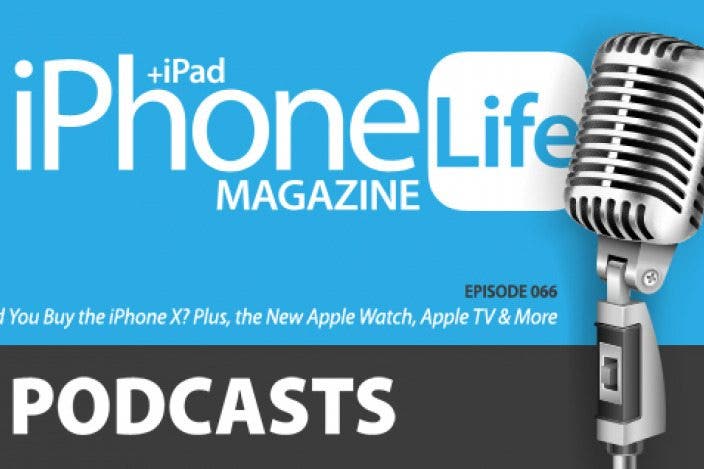
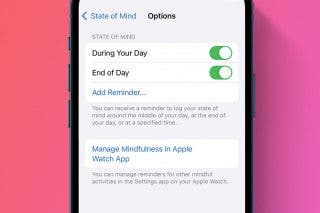
 Rhett Intriago
Rhett Intriago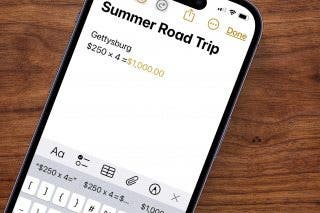
 Leanne Hays
Leanne Hays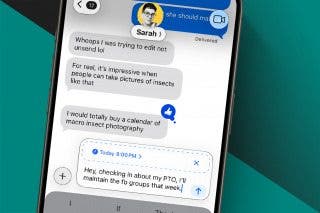
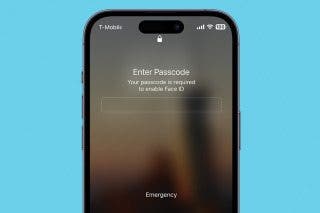
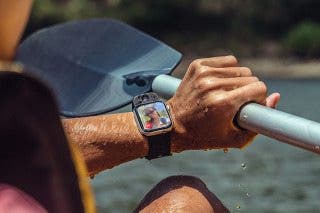
 Olena Kagui
Olena Kagui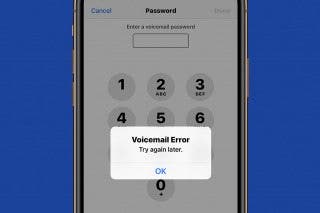
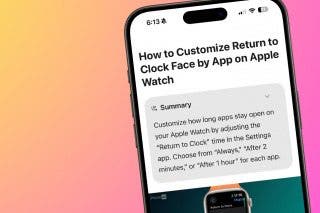
 Amy Spitzfaden Both
Amy Spitzfaden Both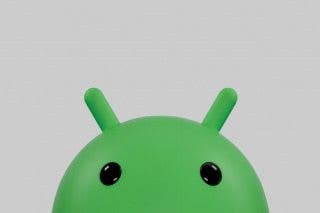
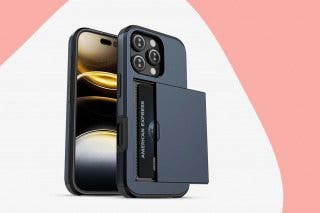
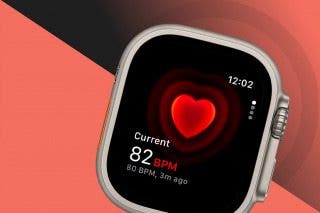


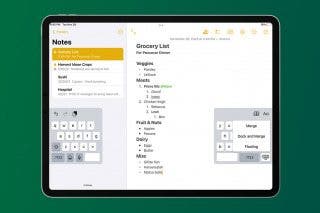
 Rachel Needell
Rachel Needell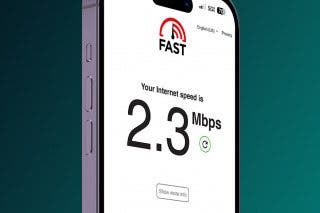
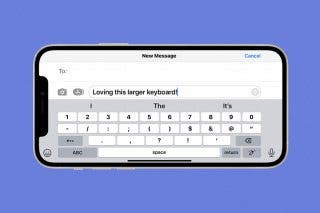
 Belinda Sanmiguel
Belinda Sanmiguel